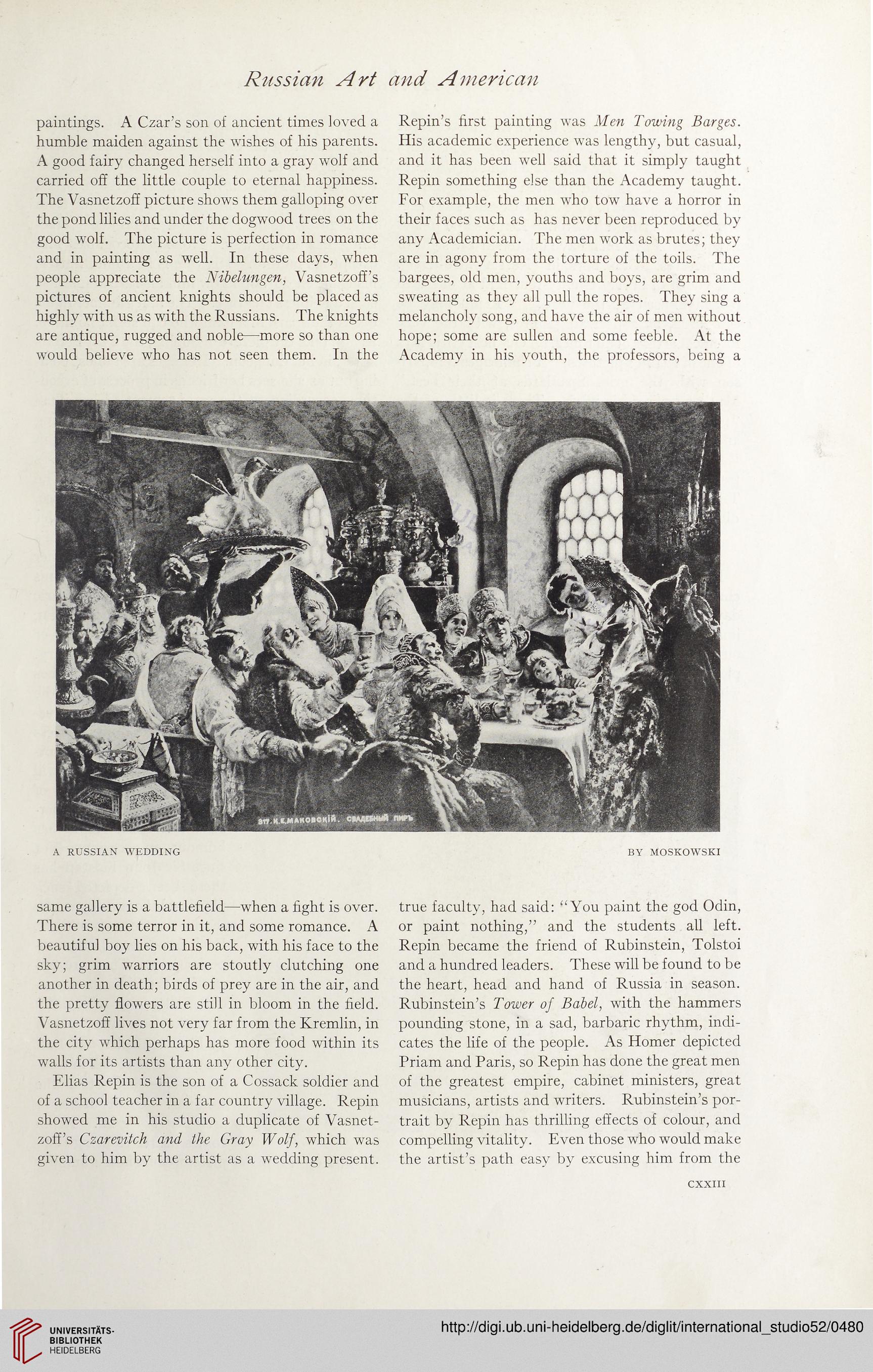Russian Art and American
paintings. A Czar’s son of ancient times loved a
humble maiden against the wishes of his parents.
A good fairy changed herself into a gray wolf and
carried off the little couple to eternal happiness.
The Vasnetzoff picture shows them galloping over
the pond lilies and under the dogwood trees on the
good wolf. The picture is perfection in romance
and in painting as well. In these days, when
people appreciate the Nibelungen, Vasnetzoff’s
pictures of ancient knights should be placed as
highly with us as with the Russians. The knights
are antique, rugged and noble—more so than one
would believe who has not seen them. In the
Repin’s first painting was Men Towing Barges.
His academic experience was lengthy, but casual,
and it has been well said that it simply taught
Repin something else than the Academy taught.
For example, the men who tow have a horror in
their faces such as has never been reproduced by
any Academician. The men work as brutes; they
are in agony from the torture of the toils. The
bargees, old men, youths and boys, are grim and
sweating as they all pull the ropes. They sing a
melancholy song, and have the air of men without
hope; some are sullen and some feeble. At the
Academy in his youth, the professors, being a
A RUSSIAN WEDDING
BY MOSKOWSKI
same gallery is a battlefield—when a fight is over.
There is some terror in it, and some romance. A
beautiful boy lies on his back, with his face to the
sky; grim warriors are stoutly clutching one
another in death; birds of prey are in the air, and
the pretty flowers are still in bloom in the field.
Vasnetzoff lives not very far from the Kremlin, in
the city which perhaps has more food within its
walls for its artists than any other city.
Elias Repin is the son of a Cossack soldier and
of a school teacher in a far country village. Repin
showed me in his studio a duplicate of Vasnet-
zoff’s Czarevitch and the Gray Wolf, which was
given to him by the artist as a wedding present.
true faculty, had said: '' You paint the god Odin,
or paint nothing,” and the students all left.
Repin became the friend of Rubinstein, Tolstoi
and a hundred leaders. These will be found to be
the heart, head and hand of Russia in season.
Rubinstein’s Tower of Babel, with the hammers
pounding stone, in a sad, barbaric rhythm, indi-
cates the life of the people. As Homer depicted
Priam and Paris, so Repin has done the great men
of the greatest empire, cabinet ministers, great
musicians, artists and writers. Rubinstein’s por-
trait by Repin has thrilling effects of colour, and
compelling vitality. Even those who would make
the artist’s path easy by excusing him from the
cxxm
paintings. A Czar’s son of ancient times loved a
humble maiden against the wishes of his parents.
A good fairy changed herself into a gray wolf and
carried off the little couple to eternal happiness.
The Vasnetzoff picture shows them galloping over
the pond lilies and under the dogwood trees on the
good wolf. The picture is perfection in romance
and in painting as well. In these days, when
people appreciate the Nibelungen, Vasnetzoff’s
pictures of ancient knights should be placed as
highly with us as with the Russians. The knights
are antique, rugged and noble—more so than one
would believe who has not seen them. In the
Repin’s first painting was Men Towing Barges.
His academic experience was lengthy, but casual,
and it has been well said that it simply taught
Repin something else than the Academy taught.
For example, the men who tow have a horror in
their faces such as has never been reproduced by
any Academician. The men work as brutes; they
are in agony from the torture of the toils. The
bargees, old men, youths and boys, are grim and
sweating as they all pull the ropes. They sing a
melancholy song, and have the air of men without
hope; some are sullen and some feeble. At the
Academy in his youth, the professors, being a
A RUSSIAN WEDDING
BY MOSKOWSKI
same gallery is a battlefield—when a fight is over.
There is some terror in it, and some romance. A
beautiful boy lies on his back, with his face to the
sky; grim warriors are stoutly clutching one
another in death; birds of prey are in the air, and
the pretty flowers are still in bloom in the field.
Vasnetzoff lives not very far from the Kremlin, in
the city which perhaps has more food within its
walls for its artists than any other city.
Elias Repin is the son of a Cossack soldier and
of a school teacher in a far country village. Repin
showed me in his studio a duplicate of Vasnet-
zoff’s Czarevitch and the Gray Wolf, which was
given to him by the artist as a wedding present.
true faculty, had said: '' You paint the god Odin,
or paint nothing,” and the students all left.
Repin became the friend of Rubinstein, Tolstoi
and a hundred leaders. These will be found to be
the heart, head and hand of Russia in season.
Rubinstein’s Tower of Babel, with the hammers
pounding stone, in a sad, barbaric rhythm, indi-
cates the life of the people. As Homer depicted
Priam and Paris, so Repin has done the great men
of the greatest empire, cabinet ministers, great
musicians, artists and writers. Rubinstein’s por-
trait by Repin has thrilling effects of colour, and
compelling vitality. Even those who would make
the artist’s path easy by excusing him from the
cxxm




